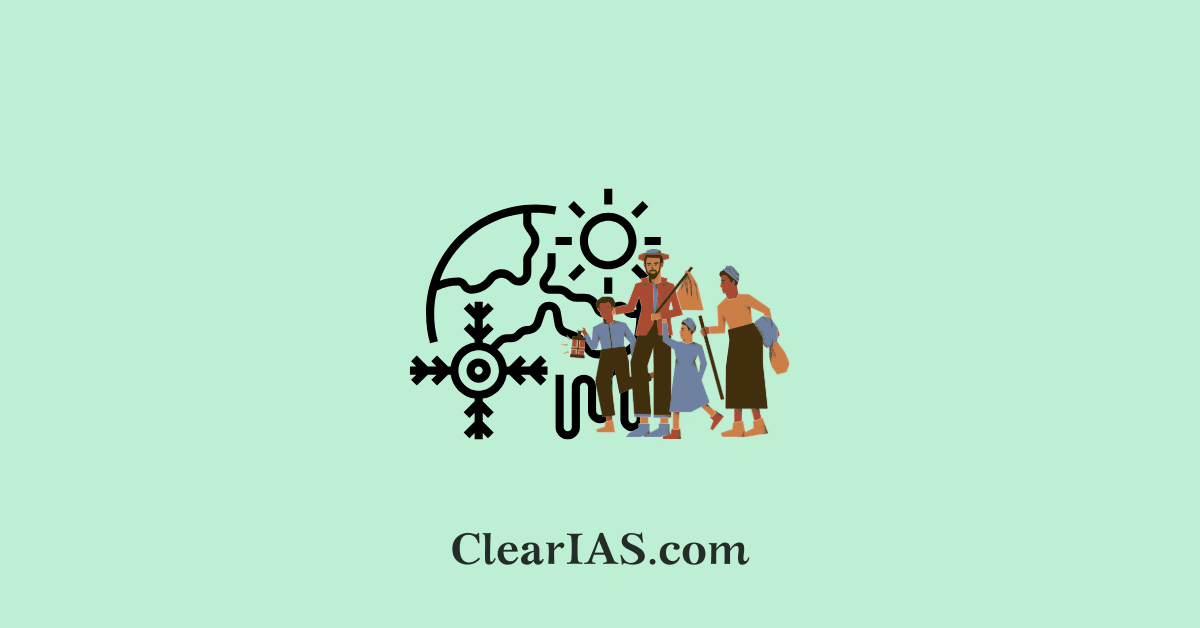
The effect of climate change on migrants is a poorly understood cause-and-effect phenomenon. Migrants, often invisible in policy debates, bear the heaviest burden. Addressing their vulnerabilities requires a rights-based, climate-resilient, and inclusive migration policy, backed by national strategies and international cooperation. Read here to learn more.
Climate change is increasingly recognised as a driver of human mobility, influencing both forced displacement and voluntary migration. Migrants, already socially and economically vulnerable, face multiple challenges that are amplified by climate risks.
Effect of Climate Change on Migrants
Climate change is no longer a distant environmental challenge; it is a lived human crisis.
Rising temperatures, erratic rainfall, sea-level rise, floods, droughts, and extreme weather events are displacing millions globally, creating a new category of people often termed climate migrants or environmentally displaced persons.
Unlike economic migrants who move voluntarily in search of better opportunities, climate migrants are often forced to relocate, either temporarily or permanently, as their habitats and livelihoods become unviable.
The World Bank (2021 Groundswell Report) projects that by 2050, over 216 million people could be displaced internally due to climate change in Sub-Saharan Africa, South Asia, and Latin America.
India, with its vast coastline, agrarian economy, and dense population, is particularly vulnerable. Regions like the Sundarbans, Bundelkhand, and drought-prone Vidarbha already show climate-linked outmigration trends.
Displacement and Forced Migration
- Loss of Habitats: Rising sea levels threaten coastal populations (e.g., Sundarbans, Maldives), forcing migration to safer zones.
- Extreme Weather: Cyclones, floods, droughts, and glacial lake outburst floods (GLOFs) displace communities with little preparedness.
- Slow-Onset Events: Desertification and changing rainfall patterns gradually push farmers out of rural areas, triggering urban migration.
Livelihood Insecurity
- Agriculture Dependence: Migrants from drought- or flood-prone areas lose traditional livelihoods in farming, fisheries, or pastoralism.
- Urban Informal Work: On migrating to cities, many are pushed into insecure, low-paying informal jobs without labour protections.
- Remittance Risks: Families dependent on remittances may face reduced income flows when migrants’ work opportunities decline due to climate stress in host regions.
Health and Well-being
- Exposure to Diseases: Migrant settlements often lack clean water, sanitation, and healthcare, raising risks of diarrhoea, malaria, and dengue.
- Mental Health: Loss of home, identity, and security fuels trauma, anxiety, and long-term psychological stress.
- Heat Stress: Migrants working in construction, agriculture, or services in urban heat islands face high vulnerability to heat waves.
Social and Political Vulnerability
- Legal Exclusion: Climate migrants lack formal recognition; they may be labelled “illegal migrants” rather than climate-displaced, restricting access to social protection and rights.
- Conflict Potential: Resource competition (water, land, jobs) between locals and migrants can escalate tensions, especially in already fragile regions.
- Discrimination & Marginalisation: Migrants often face xenophobia, exclusion from welfare schemes, and limited access to housing, education, and healthcare.
Impact on Women and Children Migrants
- Women: Face double burden of livelihood loss and domestic responsibilities, increased risks of trafficking and gender-based violence.
- Children: Interrupted schooling, malnutrition, and child labour risks increase in displaced communities.
Urban Stresses
- Rapid influx of climate migrants into cities fuels:
- Growth of slums in ecologically fragile areas (riverbanks, coastal belts).
- Pressure on urban infrastructure (water, sanitation, housing, healthcare).
- Heightened vulnerability to disasters like urban floods and heat waves.
Cross-border Implications
- Migration across borders due to climate change (e.g., Bangladesh to India) creates diplomatic, security, and humanitarian challenges.
- Lack of international legal frameworks for “climate refugees” worsens their protection gaps.
Integrating Migrants into Climate Policy
- National Policies
- Integrate migration into India’s National Action Plan on Climate Change (NAPCC) and State Action Plans (SAPCCs).
- Recognise climate migrants in legal and social frameworks.
- Strengthening Adaptive Capacity
- Invest in climate-resilient agriculture (drought-resistant seeds, irrigation, insurance).
- Promote coastal protection projects like mangrove regeneration and sea walls.
- Enhance urban resilience by planning affordable housing, water, and health services for migrants.
- Social Protection Measures
- Portability of entitlements (ration, health insurance, pensions) through schemes like One Nation One Ration Card.
- Livelihood support through MGNREGA, skilling, and job guarantees.
- International Cooperation
- Push for global recognition of “climate refugees” under UN frameworks.
- Collaborate with neighbours (Bangladesh, Nepal, Sri Lanka) on joint disaster management and migration management.
- Community Participation
- Empower Panchayati Raj Institutions and Urban Local Bodies to identify vulnerable populations and plan local adaptation strategies.
Conclusion
Migrants are both victims of climate change and agents of adaptation. While climate change intensifies their vulnerabilities, migration also acts as a coping strategy, diversifying income, spreading risks, and ensuring survival.
Thus, integrating migration into climate policy, through legal recognition, social protection, urban planning, and international cooperation, is essential to safeguard lives, livelihoods, and human dignity in a warming world.
Related articles:







Leave a Reply